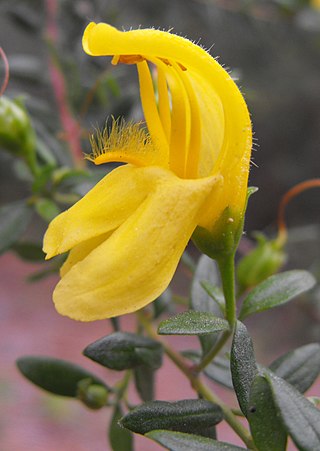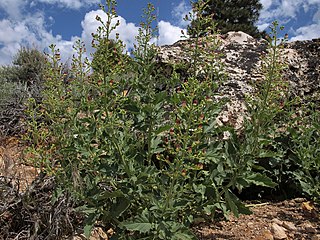Description
Keckiella breviflora is a branching, bushy shrub with many thin stems, approaching a maximum height near two meters.
Its shiny green leaves are arranged oppositely on the branches, and each is one to four centimeters long, generally lance-shaped and finely serrated or smooth along the edges.
The shrub produces tall inflorescences which are loose, glandular spikes of flowers. Each flower is one to two centimeters wide with five pale pink or pinkish-streaked white lobes whose external surfaces have long, shiny hairs. The three lower lobes curl outward from the mouth and under, and the two upper lobes are joined into a lip that curves forward over the mouth. Within the mouth are long stamen filaments bearing anthers, and a flat, hairless, sterile stamen called a staminode.

Lepechinia fragrans is a flowering herbaceous shrub known by the common names island pitchersage and fragrant pitchersage. It is a member of the Lamiaceae, or mint family, but like other Lepechinia, the flowers are borne in racemes instead of in mintlike whorls.

Ipomopsis tenuifolia is a species of flowering plant in the phlox family known by the common name slenderleaf skyrocket, or slenderleaf ipomopsis. It is native to Baja California with its range extending just into California and Arizona, where it is a plant of the deserts and chaparral. This is a perennial herb taking the form of a neat clump of slender, erect multibranched stems reaching a maximum height near 40 centimeters. The leaves are narrow to threadlike and occur all along the stem branches. The inflorescences appear at or near the tips of the branches and each holds one to seven bright scarlet flowers. Each flower is a tube 1 to 2 centimeters long opening into a flat or bell-shaped corolla with squared or toothed lobes. The five stamens and one style protrude far out of the mouth of the flower. The stamens have white to purple anthers and the style has three whitish stigmas.

Keckiella antirrhinoides is a species of flowering shrub in the plantain family known by the common names snapdragon penstemon and chaparral beardtongue.

Keckiella cordifolia is a species of flowering shrub in the plantain family known by the common name heartleaf keckiella. It is native to the coast and coastal mountains of southern California and northern Baja California, and it is a resident of chaparral and coastal woodland plant communities.

Keckiella corymbosa is a species of flowering shrub in the plantain family known by the common names redwood keckiella, red beardtongue, and red shrubby penstemon.

Caltha leptosepala, the white marsh marigold, twinflowered marsh marigold, or broadleaved marsh marigold, is a perennial species of flowering plant in the buttercup family. It is native to western North America from Alaska to New Mexico, where it grows in wet mountain habitats in alpine and subalpine regions. There are two general wild types of this species, one native to the interior and one that grows along the Pacific coast and coastal mountains, but these are not always treated separately.
Keckiella lemmonii is a species of flowering plant in the plantain family known by the common name Lemmon's keckiella.

Keckiella rothrockii is a species of flowering plant in the plantain family known by the common name Rothrock's keckiella. It is native to the desert mountains of southeastern California and adjacent Nevada, where it lives in sagebrush and woodland. This is a short, wide shrub reaching maximum heights near half a meter. The hairy green stems bear small oval-shaped leaves up to 1.5 centimeters long. The flowers vary in color from brownish to yellow to cream, and are sometimes striped with dull purple or brown. Each is up to about 2 centimeters long with curling lobes at the mouth. Inside the tubular flower are stamens, including a flat, sterile stamen known as a staminode.

Kumlienia hystricula is a species of flowering plant in the buttercup family known by the common name waterfall false buttercup.

Arctostaphylos nummularia subsp. mendocinoensis, commonly known as pygmy manzanita, is a subspecies of manzanita. It is endemic to Mendocino County, California, where it is known from scattered occurrences in the pygmy forests near the coast.

Arctostaphylos nissenana is a species of manzanita known by the common name Nissenan manzanita. It is endemic to California, where it grows in the woodlands and chaparral of the Sierra Nevada foothills, mostly in El Dorado County.

Keckiella ternata is a species of flowering plant in the plantain family known by the common name scarlet keckiella.

Ribes speciosum is a species of flowering plant in the family Grossulariaceae, which includes the edible currants and gooseberries. It is a spiny deciduous shrub with spring-flowering, elongate red flowers that resemble fuchsias, though it is not closely related. Its common name is fuchsia-flowered gooseberry. It is native to central and southern California and Baja California, where it grows in the scrub and chaparral of the coastal mountain ranges.

Ranunculus eschscholtzii is a species of buttercup flower known by the common name Eschscholtz's buttercup.
Ribes binominatum is a species of currant known by the common names trailing gooseberry and ground gooseberry.
Ribes lasianthum is a species of currant known by the common names alpine gooseberry and woolly-flowered gooseberry. It is native to California, where it can be found in the San Gabriel Mountains and the Sierra Nevada, its distribution extending just into Nevada.

Ribes roezlii is a North American species of gooseberry known by the common name Sierra gooseberry.

Scrophularia desertorum is a species of flowering plant in the figwort family known by the common name desert figwort. It is native to Nevada and eastern California where it grows in dry areas in local mountain ranges, including the Sierra Nevada and the desert ranges adjacent. It is a perennial herb producing clusters of erect stems that often exceed one meter tall. The leaves have toothed, triangular or lance-shaped blades up to 13 centimeters long which are borne on petioles measuring up to 10 centimeters in length. The inflorescence is a wide-open panicle with several hairy, glandular branches bearing flowers. The flower has a spherical corolla opening at the top into a hoodlike, lobed mouth. The corolla is just under a centimeter long and is whitish at the base and deep red around the mouth and on the lobes. The staminode is generally visible in the mouth of the corolla. The fruit is a capsule just under a centimeter long containing many seeds.
Tetracoccus ilicifolius is a rare species of flowering shrub in the family Picrodendraceae known by the common names hollybush and holly-leaved tetracoccus.

Triteleia dudleyi is a species of flowering plant known by the common name Dudley's triteleia. It is endemic to California, where it is known from sections of the High Sierra Nevada and the Transverse Ranges. It is a plant of subalpine climates, growing in mountain forests. It is a perennial herb growing from a corm. It produces two or three basal leaves up to 30 centimeters long by one wide. The inflorescence arises on an erect stem up to 30 or 35 centimeters tall and bears an umbel-like cluster of many flowers. Each flower is a funnel-shaped yellow bloom that dries purple. The flower has six lobes measuring up to 1.2 centimeters long. There are six stamens with lavender anthers.
This page is based on this
Wikipedia article Text is available under the
CC BY-SA 4.0 license; additional terms may apply.
Images, videos and audio are available under their respective licenses.
















